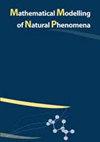Mathematical Modeling of Aphron Drilling nanofluid Driven by Electroosmotically Modulated Peristalsis Through a Pipe
IF 2.1
4区 数学
Q2 MATHEMATICAL & COMPUTATIONAL BIOLOGY
引用次数: 8
Abstract
This analysis is conducted for a theoretical examination of the fluid flow characteristics and heat transferred by the nanoparticle-enhanced drilling muds flowing through drilling pipes under various physical conditions. Here, an important type of drilling fluid called Aphron drilling fluid is under consideration which is very effective for drilling in depleted regions. The rheological characteristics of the drilling fluid are predicted by Herschel-Bulkley fluid model. The fluid flow is driven by peristaltic pumping which is further aided by electroosmosis. The zinc oxide nanoparticles are dispersed in the aphron drilling fluid to prepare the nanofluid. The administering set of equations are simplified under the lubrication approach and the closed-form solutions are obtained for velocity and pressure gradient force. However, numerical solutions are executed for the temperature of nanofluid through built-in routine bvp4c of MATLAB. Fluid flow characteristics are analyzed for variation in physical conditions through graphical results. The outcomes of this study reveal that velocity profile substantially rises for application of forwarding electric field and temperature profile significantly decays in this case. An increment in temperature difference raises the magnitude of the Nusselt number. Furthermore, the nanoparticle volume fraction contributes to fluid acceleration and thermal conductivity of the drilling fluid.电渗调节蠕动驱动Aphron钻井纳米流体的数学模型
对纳米颗粒增强钻井液在不同物理条件下流经钻杆的流体流动特性和传热特性进行了理论分析。在这里,一种重要的称为Aphron的钻井液正在考虑中,它对枯竭地区的钻井非常有效。利用Herschel-Bulkley流体模型预测了钻井液的流变特性。流体流动由蠕动泵送驱动,电渗透进一步辅助。将氧化锌纳米颗粒分散在aphron钻井液中制备纳米流体。在润滑方法下简化了控制方程组,得到了速度梯度力和压力梯度力的封闭解。然而,通过MATLAB内置的bvp4c程序对纳米流体的温度进行了数值求解。通过图形结果分析了流体流动特性在物理条件下的变化。研究结果表明,在这种情况下,速度分布在转发电场的作用下显著上升,温度分布在转发电场的作用下显著衰减。温差的增加使努塞尔数的大小增大。此外,纳米颗粒体积分数有助于钻井液的加速和导热性。
本文章由计算机程序翻译,如有差异,请以英文原文为准。
求助全文
约1分钟内获得全文
求助全文
来源期刊

Mathematical Modelling of Natural Phenomena
MATHEMATICAL & COMPUTATIONAL BIOLOGY-MATHEMATICS, INTERDISCIPLINARY APPLICATIONS
CiteScore
5.20
自引率
0.00%
发文量
46
审稿时长
6-12 weeks
期刊介绍:
The Mathematical Modelling of Natural Phenomena (MMNP) is an international research journal, which publishes top-level original and review papers, short communications and proceedings on mathematical modelling in biology, medicine, chemistry, physics, and other areas. The scope of the journal is devoted to mathematical modelling with sufficiently advanced model, and the works studying mainly the existence and stability of stationary points of ODE systems are not considered. The scope of the journal also includes applied mathematics and mathematical analysis in the context of its applications to the real world problems. The journal is essentially functioning on the basis of topical issues representing active areas of research. Each topical issue has its own editorial board. The authors are invited to submit papers to the announced issues or to suggest new issues.
Journal publishes research articles and reviews within the whole field of mathematical modelling, and it will continue to provide information on the latest trends and developments in this ever-expanding subject.
 求助内容:
求助内容: 应助结果提醒方式:
应助结果提醒方式:


